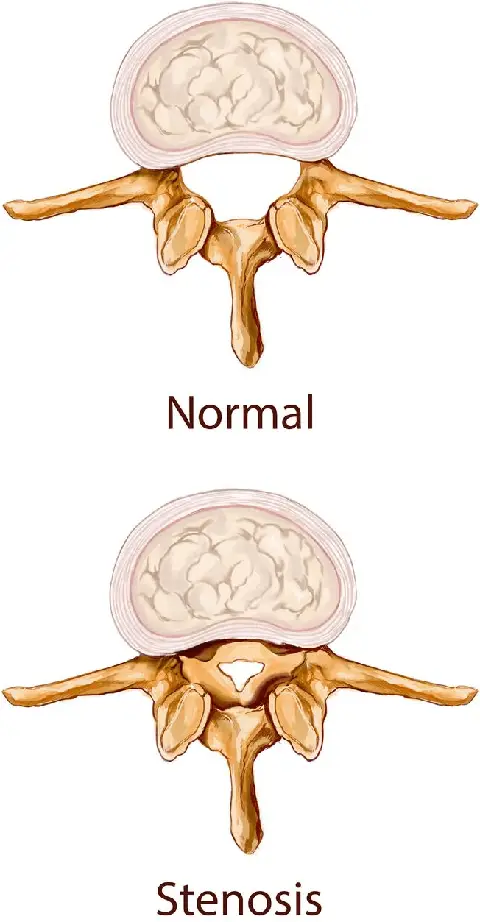Spinal stenosis is a medical condition that affects the spinal cord and nerves. It occurs when the spaces within the spine become narrower, which can put pressure on the nerves and spinal cord. This pressure can cause pain, numbness, weakness, and other symptoms that can affect a person’s daily life.
The spine is made up of 33 vertebrae that are stacked on top of each other. Between each vertebra, there is a small space called the spinal canal that houses the spinal cord and nerves. Spinal stenosis occurs when the spinal canal becomes narrower, which can compress the nerves and spinal cord.
There are two main types of spinal stenosis: lumbar spinal stenosis and cervical spinal stenosis. Lumbar spinal stenosis occurs in the lower back and is more common, while cervical spinal stenosis occurs in the neck.
The most common causes of spinal stenosis are age-related changes in the spine, such as degenerative disc disease, osteoarthritis, and herniated discs. Other causes may include congenital defects, tumors, and spinal injuries.
The most common causes of spinal stenosis are age-related changes in the spine, such as degenerative disc disease, osteoarthritis, and herniated discs. Other causes may include congenital defects, tumors, and spinal injuries.

Spinal stenosis can cause a range of problems, including reduced mobility, difficulty performing daily activities, and chronic pain. If left untreated, it can also lead to permanent nerve damage, which can have long-term consequences.
The typical treatments for spinal stenosis include rest, physical therapy, pain medications, and, in severe cases, surgery. However, chiropractic care can be a safe and effective alternative that can help address the root cause of the problem and promote healing.
Chiropractors use a variety of techniques to treat spinal stenosis, such as spinal adjustments, massage therapy, and stretching exercises. These techniques can help decrease pain, increase range of motion, and reduce inflammation in the affected area. Additionally, chiropractic care can help improve overall spinal health, which can help prevent future episodes of spinal stenosis.
Spinal adjustments involve the application of controlled force to the spine to realign the vertebrae and relieve pressure on the nerves and spinal cord. Massage therapy can help reduce muscle tension and improve circulation in the affected area, while stretching exercises can help improve flexibility and range of motion.
In addition to these techniques, chiropractors may also recommend lifestyle changes such as exercise, proper nutrition, and stress reduction techniques to help manage spinal stenosis symptoms.
Chiropractic care is a non-invasive and safe treatment option for spinal stenosis. Unlike medications, which only mask the symptoms, chiropractic care can help improve the lives of people with this condition by addressing the underlying problem. If you’re experiencing symptoms of spinal stenosis, it’s worth considering chiropractic care as an option to help manage your pain and improve your quality of life.
Chiropractic Care Utilizing Zone Technique for Spinal Stenosis
Any Zone Technique healer, including Dr. Post, knows exactly what to do for any condition walking into the office, including spinal stenosis in any part of the spine. Since Zone Technique is able to unlock and unleash the powerful healing ability withing your body, your healing results will be exponentially better than any other healing technique available today. Whether you have or someone else you know has spinal stenosis, balancing the body by utilizing Zone Technique will heal your body on a very deep level. Zone Technique healing is natural, effective, and permanent so that you will heal completely, function great and no longer have pain. You can be totally healthy again – feeling great and functioning perfectly from head to toe every day of the year!
If you don’t live close enough to see Dr. Post, search for a certified Zone Technique healer closer to you by searching the ZONE TECHNIQUE PRACTITIONER DIRECTORY. You owe it to yourself to take action so that you can heal and feel awesome again.
If you have been told that you have spinal stenosis, have symptoms consistent with a diagnosis of spinal stenosis and/or don’t want to go through medical treatments for this condition feel free to make an appointment with Dr. Post for a consultation and/or to begin chiropractic treatment utilizing the Zone Technique. It is not only non-invasive, it is the safest and most effective way to eliminate all the symptoms of spinal stenosis so you are pain free, flexible, move easily (like you used to) and function perfectly.

